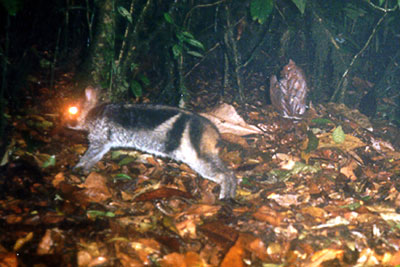
Large-antlered muntjak (Muntiacus vuquangensis) and unidentified poachers (below) in Nakai-Nam Theun National Protected Area, Laos. Copyright 2007 Nam Theun 2 Watershed Management and Protection Authority.

Rare Jungle Deer Photographed For The First Time
A camera trap has captured the first ever pictures of an elusive forest deer in its natural habitat, reports the Wildlife Conservation Society (WCS).
The deer, called a large-antlered muntjak, was previously known only from specimens collected by hunters and a few brief glimpses by biologists. The species stands approximately 25-30 inches tall (65-80 cm) and weighs up to 110 pounds (50 kilograms).
The photographs were taken using “camera traps” set in Laos’ Nakai Nam Theun National Protected Area (NNT NPA), in the Annamite Mountains, a densely forested mountain chain that straddles the Laos-Vietnam border and is considered one the world’s biodiversity hotspots. In recent years several previously unknown species has been discovered in the Annamites, which are also home to tigers, Asian elephants, and the highly endangered red-shanked douc monkey.
“This region is extraordinary for it’s distinctive wildlife,” said Dr. Arlyne Johnson, co-director of the WCS Lao Program. “We are delighted to be working with the WMPA to ensure a future for not only the large-antlered muntjak and Annamite striped rabbit, but the many other rare species that call this globally important region their home.”mongabay.com

The Sumatran striped rabbit (Nesolagus netscheri) was also captured on a trailcam.
The photograph of this muntjak confirms its Laotian location, as it was first known from skulls Vietnam.
Cryptozoologist, Cryptomundo friend, and Australian scholar Vern Weitzel, living in Ba Dinh, Ha Noi, has noted the following:

The three specimens on the right are skulls of the newly discovered robust muntjak deer Megamuntiacus vuquangensis in the Forest Inventory and Planning Institute in Hanoi. This species is now known to occur in border areas between Vietnam, Cambodia and Laos. The skull on the fare left is of a common muntjak Muntiacus muntjak which also occurs in Vietnam. Credit: Vern Weitzel.
Follow CryptoZooNews
Not Found
The resource could not be found.